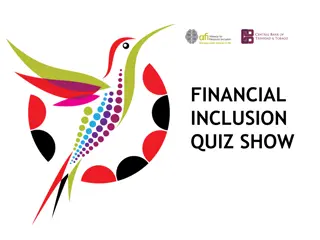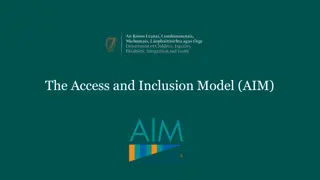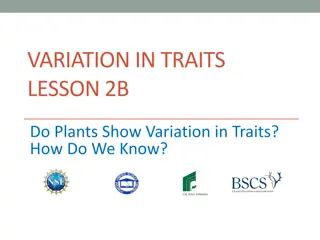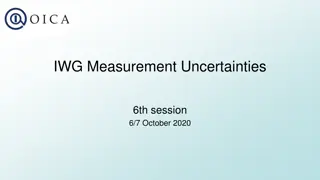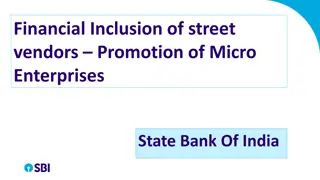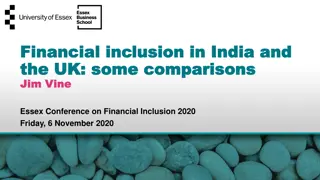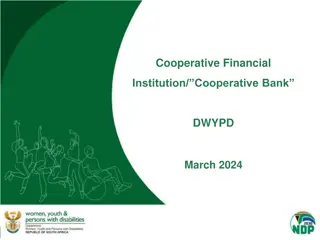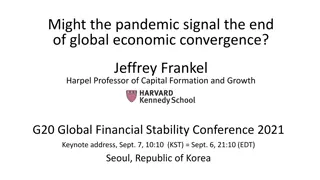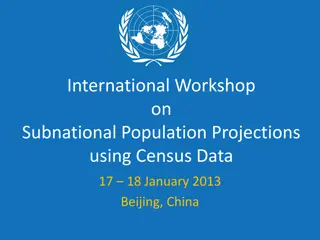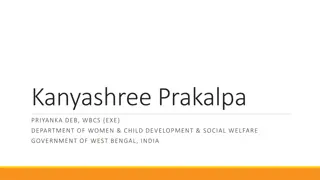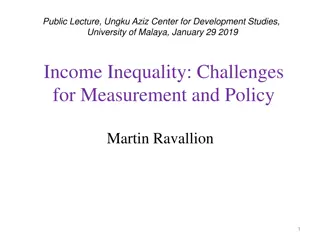Understanding Global Financial Inclusion Variations
Examining cross-country variations in financial inclusion, this study emphasizes the importance of a multidimensional measure to assess access, use, and depth of financial services globally. Highlighting the significance of government policies and technology, the research aims to identify factors influencing financial inclusion across different economies and their impacts on banking conditions.
Download Presentation

Please find below an Image/Link to download the presentation.
The content on the website is provided AS IS for your information and personal use only. It may not be sold, licensed, or shared on other websites without obtaining consent from the author. Download presentation by click this link. If you encounter any issues during the download, it is possible that the publisher has removed the file from their server.
E N D
Presentation Transcript
Cross-country variation in financial inclusion: a global perspective Mais Sha ban Claudia Girardone Anna Sarkisyan Essex Conference on Financial Inclusion 2020 Mainstreaming financial inclusion Essex Business School , November 6,2020
Financial inclusion means that individuals and businesses have access to useful and affordable financial products and services that meet their needs transactions, payments, savings, credit and insurance delivered in a responsible and sustainable way. (World Bank, 2018)
Background Global commitment to advancing financial inclusion as a key enabler for 8 of the Sustainable Development Goals (SDGs) 2030 including; lower poverty, higher development, and equal opportunity According to the World Bank there has been some improvement in financial inclusion as the share of adults owning an account increased from 51% in 2011 to 62% in 2014 and 69% in 2017 Progress has been mainly driven by government policies and the use of technology. However variation across countries is still very high For example in the Sub-Saharan Africa region the progress has been mainly achieved through new mobile accounts. In India, mainly through financial institutions In addition financial inclusion is not just about having an account; the actual use is what matters for achieving the benefits of financial inclusion
Aims of Study The heterogeneity in financial inclusion has highlighted the need for a multidimensional measure of financial inclusion that is comparable across economies to identify the current state, set targets and policies, and monitor progress In this study we construct a financial inclusion index that captures different dimensions: use, access, and depth of financial services. This is motivated by the inadequacy of focusing on a single measure to represent and summarise the extent of financial inclusion in a country Additionally, high variation in financial inclusion between countries motivates the need to investigate factors that explain it. This is also useful for policy We examine the relationship between financial inclusion and different country characteristics, with a special focus on banking conditions
Selected Literature Review 1/2 One strand of the literature focuses on single measures of financial inclusion The proportion of adults that have an account (Allen et al., 2016) Account usage that captures the frequency or the volume of account use (Demirguc-Kunt, Klapper, & Singer, 2013) Branch penetration and mobile money (Ardic et., 2011) A second more recent strand of literature proposes composite indices of financial inclusion capturing its multidimensional and complex nature. Methods include: a non-parametric approach where the weights for the components of the financial inclusion index are assigned exogenously, based on a judgement element (Sarma, 2008, 2012) a parametric approach that allows for the weights to be assigned endogenously, based on the information structure of the data (Camara & Tuesta, 2014)
Selected Literature Review 2/2 In terms of factors affecting inclusion, the empirical literature points to certain country characteristics that play a role in determining the level of financial inclusion: Macro-economic factors: level of income, employment, and inflation (Ardic et al., 2011; Allen et al., 2012; Park and Mercado, 2018) Banking system conditions: competition, concentration, financial freedom, and regulation (Rojas-Suarez, 2010) Institutional environment: government integrity (Demirg -Kunt and Klapper, 2013) Technological factors: internet usage (Kabakova and Plaksenkov, 2018) Social factors: human development (Kabakova & Plaksenkov, 2018)
Contributions We construct a multidimensional financial inclusion index using both a non- parametric and a parametric approach, namely, a standard geometric mean and a more sophisticated principal component analysis We expand the time span of the existing research on financial inclusion. Specifically, we focus on a sample of 95 economies over a relatively long time period (2004-15) that enables us to analyse trends and perform regression analysis We assess a comprehensive set of factors in their relation to financial inclusion, including banking system conditions Finally, we test whether the relation between these factors and financial inclusion varies across countries with different income level
Data The data are drawn from the following sources: Country-level financial inclusion data - the IMF Financial Access survey (FAS) dataset Country-level economic and technological data - World Bank Development Indicators Country-level banking structure and competition data - Global financial development database Banking regulation data - World Bank Surveys on bank regulation (by Barth et., al 2012) Banks financial freedom and institutional quality - the Heritage foundation Social factors - UN Human Development reports
Methodology: Index Construction We employ a non-parametric approach to derive an equally-weighted composite index: 1. Normalise the six indicators of financial inclusion using empirical normalisation to arrive at a common scale ranging from 0 to 1 2. Theses indicators are used to calculate three dimensional indices - use index, access index, and depth index. Each dimensional index is derived by taking the arithmetic mean of the two corresponding indicators 3. The three dimensional indices are aggregated into the composite financial inclusion index using the geometric mean as follows: ????????? ????????? ????? = (??? ????? ?????? ????? ????? ?????)?/? Step 1: Indicators Deposit accounts Loan accounts Branches ATMs Deposits to GDP Loans to GDP Step 2: Dimensional indices Use index Access index Depth index Financial inclusion index Step 3: Aggregate index
Index Results (1) The average score of our financial inclusion index shows that the most inclusive systems are developed countries that have high or upper-middle income. Spain, Japan, and Portugal score the highest average over the period While low income countries such as Congo and South Sudan have the lowest financial inclusion and India ranks 54th
Index Results (2) On average: There seems to be progress in financial inclusion over the sample period The progress appears most prominent in the use and access dimensions High and upper-middle income countries over-rank low and lower- middle income countries
Index Results (3) .4 Financial inclusion index .3 .2 .1 0 2004 2005 2006 2007 2008 2009 2010 2011 2012 2013 2014 2015 Year Europe & Central Asia Latin America & Caribbean East Asia & Pacific Full sample Middle East & North Africa Sub-Saharan Africa South Asia On average: European countries over-rank other regions The Sub-Saharan African region ranks the lowest Sub-Saharan Africa and South Asia show improvement in financial inclusion over time
Financial inclusion and country-level characteristics Model (1) Model (2) Model (3) Model (4) Model (5) GDP per capitat-1 0.1168** 0.0987** (3.99) (5.08) Unemploymentt-1 -0.0005 -0.0015** -0.0033** -0.0029** -0.0033** (-0.61) (-2.07) (-3.23) (-2.64) (-2.96) Inflationt-1 -0.0007** -0.0009** -0.0003 -0.0004 -0.0004 (-2.13) (-2.86) (-1.08) (-1.24) (-1.10) - Greater competition, bank capital regulation , and financial freedom associated financial inclusion banking system concentration, Boone indicator-1 -0.0583** -0.0435** -0.0433** -0.0330** (-3.24) (-3.34) (-2.92) (-2.62) are Bank concentrationt-1 0.0009** 0.0012** 0.0010** 0.0009** with higher (2.16) (2.35) (2.09) (2.08) Capital regulationt-1 0.0025 0.0028 0.0031 0.0042** (1.16) (1.25) (1.41) (2.03) - Higher government integrity, human development, usage are positively related to financial inclusion levels of income, Financial freedomt-1 0.0006 0.0008 0.0005 0.0012** and internet (1.26) (1.56) (0.97) (2.37) Government integrityt-1 0.0012** (2.14) HDIt-1 1.1572** - While high unemployment and inflation are associated with inclusion (3.92) negatively financial Individuals using internett-1 0.0019** (3.36) Constant -0.7453** -0.6886** 0.1096 -0.6633** 0.0797 (-2.91) (-3.63) (1.52) (-2.92) (1.39) Country fixed effects Yes Yes Yes Yes Yes Time fixed effects Yes Yes Yes Yes Yes Clustering Yes Yes Yes Yes Yes Observations 449 343 343 342 343 Adjusted R-squared (within) 0.267 0.309 0.208 0.233 0.272 Robust t-statistics in parentheses *** p<0.01, ** p<0.05, * p<0.1
Other results We re-construct the financial inclusion index using a two-stage principal component analysis (PCA) and re-estimate the baseline regressions with this index as the dependent variable Results largely confirm the baseline findings We examine whether the association between financial inclusion and the country- level factors varies across countries with different income levels We find that bank competition and internet usage appear to be more important for enabling financial inclusion in low income countries We conduct a number of robustness tests including: reconstructing the index setting the minimum and maximum values for our six financial inclusion indicators as the naturalzeros and aspirationaltargets , respectively controlling for the potential impact of the financial crisis on financial inclusion by dropping the crisis years 2008-09 from our sample The results of the tests are largely consistent with our baseline findings
Sum up / Conclusions Our results suggest considerable progress in financial inclusion over the period under investigation, most markedly in the use and access dimensions Our findings indicate that financial inclusion is positively and significantly associated with GDP per capita, employment, bank competition, human development, government integrity, and internet usage Our evidence also highlights the importance of considering the level of national income when designing policies to boost financial inclusion Policy-makers worldwide should consider taking more action, particularly in countries with lower income, to improve the environment to stimulate bank competition and the use of technology in conjunction to achieve greater financial inclusion
Variables Definition Source Financial inclusion Financial inclusion index An aggregate financial inclusion indicator at a country level based on three dimensions: use, access, Authors calculations and depth. It ranges from 0 to 1, with a higher value indicating greater financial inclusion. Use Deposit accounts with commercial banks (per 1,000 adults). FAS Loan accounts with commercial banks (per 1,000 adults). FAS Access Branches of commercial banks (per 100,000 adults). FAS ATMs (per 100,000 adults). FAS Depth Bank deposits (% of GDP). GFDD Domestic credit to private sector by banks (% of GDP). GFDD Macroeconomic factors GDP per capita Gross domestic product divided by mid-year population (log). WDI Unemployment Share of the total labour force that is without work but available for and seeking employment (%). WDI Inflation Inflation measured as the annual growth rate of the GDP implicit deflator. The GDP implicit deflator WDI is the ratio of GDP in current local currency to GDP in constant local currency. Banking system conditions Boone indicator A measure of degree of competition based on profit-efficiency in the banking market. It is calculated GFDD as the elasticity of profits to marginal costs. A higher value of the Boone indicator implies a lower level of competition. Bank concentration The degree of concentration of deposits in the 5 largest banks. Bank Regulation Surveys (Barth et al., 2012) Capital regulation Sum of Overall Capital Stringency and Initial Capital Stringency. It ranges between 0-10, where a Bank Regulation Surveys (Barth et al., higher value indicates a higher level of capital stringency. 2012) Financial freedom An indicator of banking efficiency as well as a measure of independence from government control and Heritage interference in the financial sector. It ranges between 0-100, where a higher value indicates a higher level of financial freedom.
Institutional environment Government integrity Derived by averaging scores for the following factors, all of which are weighted equally: public trust in Heritage politicians, irregular payments and bribes, transparency of government policymaking, absence of corruption, perceptions of corruption, and governmental and civil service transparency. It ranges between 0-100, where a higher value indicates a higher level of government integrity. Socioeconomic factors HDI (Human development index) Summary measure of average achievement in key dimensions of human development: health, education, and UN human standard of living. It ranges between 0-1, where a higher value indicates a higher level of human developments reports development. Technological factors Individuals using internet Internet users are individuals who have used the internet (from any location) in the last 3 months (% of WDI population). The internet can be used via a computer, mobile phone, personal digital assistant, games machine, digital TV, etc. Note: The table defines the variables used in the analysis and data sources.
Panel A: Full sample Variable Obs Mean Std. Dev. Min Max Deposit accounts with commercial banks (per 1,000 adults) 779 1092.14 1148.59 13.23 7211.21 Loan accounts with commercial banks (per 1,000 adults) 779 293.77 295.57 1.30 1275.83 Branches of commercial banks (per 100,000 adults) 779 16.77 17.81 0.61 99.24 ATMs (per 100,000 adults) 779 34.65 35.05 0.05 157.36 Bank deposits (% of GDP) 779 49.82 38.83 5.07 217.53 Domestic credit to private sector by banks (% of GDP) 779 44.54 33.40 2.63 156.12 Financial inclusion index 773 0.20 0.16 0.00 0.68 GDP per capita 779 8.24 1.30 5.45 10.81 Unemployment 508 9.49 7.09 0.50 32.20 Inflation 779 5.45 6.15 -15.71 29.05 Boone indicator 688 -0.06 0.11 -0.65 0.24 Bank concentration 524 74.24 19.05 37.01 100.00 Capital regulation 583 6.64 2.11 1.00 10.00 Financial freedom 721 50.79 15.66 20.00 90.00 Government integrity 727 36.67 16.01 10.00 87.00 HDI 771 0.66 0.14 0.34 0.91 Individuals using internet 770 29.54 24.22 0.51 89.63 Panel B: Income groups High income group Low income group Difference in means (%) Obs Mean Obs Mean Deposit accounts with commercial banks (per 1,000 adults) 425 1629.66 354 446.82 256*** Loan accounts with commercial banks (per 1,000 adults) 425 455.55 354 99.56 358*** Branches of commercial banks (per 100,000 adults) 425 23.69 354 8.46 180*** ATMs (per 100,000 adults) 425 53.94 354 11.49 370*** Bank deposits (% of GDP) 425 63.95 354 32.86 95*** Domestic credit to private sector by banks (% of GDP) 425 60.44 354 25.46 137*** Financial inclusion index Note: The table reports descriptive statistics Panel A reports summary statistics for variables used in the analysis for the full sample of 95 countries over the period 2004-15. Panel B reports the comparison of financial inclusion variables between the sub-samples of high (and upper middle) income and low (and lower middle) income countries, with the t-test for the equality of means reported in the last column. *, **, *** indicate significance at 10 percent, 5 percent, and 1 percent levels, respectively. Definitions of the variables are provided in Appendix B. 425 0.29 348 0.09 239***
Indices Indicators Normalised weights Use Deposit accounts with commercial banks (per 1,000 adults) 0.633 Loan accounts with commercial banks (per 1,000 adults) 0.367 Access Branches of commercial banks (per 100,000 adults) 0.591 ATMs (per 100,000 adults) 0.409 Depth Bank deposits (% of GDP) 0.574 Domestic credit to private sector by banks (% of GDP) 0.426 Aggregate Use 0.298 Access 0.293 Depth 0.408 Note: The table reports the weights of (i) financial inclusion indicators in the respective dimensional indices and (ii) dimensional indices in the aggregate financial inclusion index, both obtained from principal component analysis. Definitions of the variables are provided in Appendix B.


